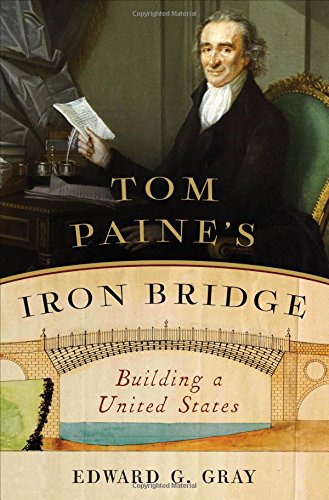
Tom Paine's Iron Bridge
Building a United States
کتاب های مرتبط
- اطلاعات
- نقد و بررسی
- دیدگاه کاربران
نقد و بررسی

January 4, 2016
Many Americans think of Tom Paine as a great champion of independence from Britain, and as a skilled firebrand. Gray (Colonial America: A History in Documents), professor of history at Florida State University, brings the radical pamphleteer alive as an architect of iron bridges. He makes a good case that Paine’s hopes for the infant United States went beyond its political independence. Wanting also to help unite the country, Paine applied his amateur design skills to the idea of physically knitting together the American territory. Understanding that the nation’s many rivers were obstacles to commerce as well as avenues of transportation, he saw the need to bridge them. Unfortunately, hard luck, ideological battles, difficulties with public authorities (in the U.S., Britain, and France), and an inveterate penury thwarted Paine’s schemes. But as he’d proved in his political writings, his visions were sound even if his execution of them was not. Others in the U.S. and elsewhere eventually erected iron bridges, some at least modestly influenced by his designs and models. Gray’s prose is lively; the solid tale he tells may be of no major significance to a broader historical understanding, but it adds to the body of knowledge about a passionate man and the tumultuous era in which he lived. Illus.

January 15, 2016
The story of a man committed to transforming the landscape of the new world. Besides being a gadfly, political theorist, and enormously popular pamphleteer, Thomas Paine (1737-1809) was an architect, determined to design an iron bridge, economically crucial, over the Schuylkill River in Pennsylvania. Gray (History/Florida State Univ.; New World Babel: Languages and Nations in Early America, 2014, etc.) sets Paine's engineering project against a backdrop of political turmoil as the Colonies struggled for independence and responded to the French Revolution. In 1775, the prospect of breaking ties with Great Britain generated fierce controversy. "To separate from the United Kingdom," many colonists thought, "was to challenge the political wisdom of centuries," which held that a "hereditary monarchy [was] the only way to political stability." Paine's Common Sense, published in 1776, contested that view, and within a year, up to 150,000 copies were circulated, with huge impact. Over the next six years, he followed with a series of 13 essays called The American Crisis, exhorting Americans "that theirs was the just cause" and bolstering the morale of beleaguered troops. Paine never grew wealthy from his writing, always returning profits to his publishers to ensure continued printings. As much as he inspired his countrymen, he incited detractors, and by the 1780s, he sought to break with his radical past. "The quiet field of science has more amusement to my mind than politics," he declared. But although he poured his energies into designing an iron bridge, he could not fully break from politics: Rights of Man appeared in 1791, with a printing of between 100,000 and 200,000 in three years. The Age of Reason was published in 1794; "among the fiercest attacks on organized Christianity ever written," it earned him new enemies. Although the author repeatedly shifts the focus to Paine's engineering project, he inevitably returns to the more compelling facts of Paine's political career. A fresh look at an influential political activist.
COPYRIGHT(2016) Kirkus Reviews, ALL RIGHTS RESERVED.

February 1, 2016
Thomas Paine (1737-1809) is renowned for his pamphlet Common Sense, which ignited revolutionary spirit and inspired America to declare independence from Britain, but Gray (history, Florida State Univ.; The Making of John Ledyard) focuses on Paine's crusade to build an innovative iron bridge across the Schuylkill River, connecting Pennsylvania's western agricultural region with its commercial east. This book is not merely a treatment of Paine's architectural career, but an explanation of how it stemmed from, and was derailed by, his work as a political writer and activist. Contrary to Paine's detractors, Gray argues that Paine was motivated by selfless concern for the common good and the stability of the republic. Therefore, his interest in bridges was an extension of, not a departure from, his political thought. After his misinterpreted support of the French Revolution and controversial radical writings, Paine's reputation was shattered, along with his hopes for financial and political backing for his iron bridge. VERDICT This small book covers broad and seemingly disparate territory, but Gray skillfully weaves Paine's ideology, altruism, and concern for the preservation of liberty. A valuable addition to academic and popular collections.--Margaret Kappanadze, Elmira Coll. Lib., NY
Copyright 2016 Library Journal, LLC Used with permission.

























دیدگاه کاربران